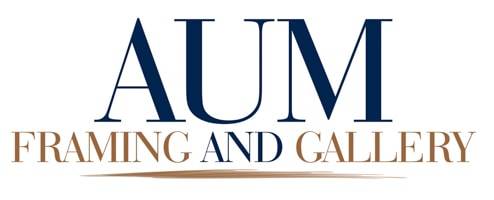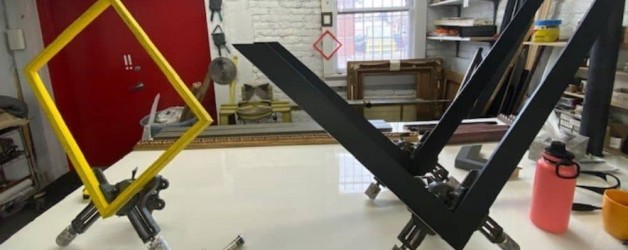Custom framing is typically done when artwork won’t fit into a standard sized frame or you’re looking for a unique design or a more refined look than is available with mass-produced off-the-shelf frames. It’s a labor intensive process, but the results will astound you.
I know I’m biased but I truly believe my team of experts at AUM Framing & Gallery / Dry Creek Gold Leaf genuinely offers the best custom framing in Denver. Don’t get me wrong; I don’t underestimate our main competitors but no-one else in the Denver area can offer the selection we can (thousands of frame choices on our walls in addition to our in-house offerings) or the level of expertise and experience our staff possess. We have 3 staff each with over 30 years experience and 2 more with over 10 years. Together, that’s over 100 years in this industry.
Design Session
We’re known for our unique and breathtaking designs. We can make your artwork pop. We’ll help you select the perfect frame for your artwork and your home during the design session, which is free. During this design session, we’ll ask you about your preferences, where in your home the artwork will be hung, and discuss budget. Since we have the largest selection of pre-finished moulding samples in the area and we also build our own wood and steel frames we’re confident our designers will present you with the perfect frame choice.
The design session can include selecting mats, spacers, fillets, mounting, backing, in fact all the elements of the construction depending on the type of frame and artwork. If all this seems overwhelming don’t worry, our designers will explain each element along with the choices available and their recommendation.
Currently, design sessions are by appointment only so that there’s only one design occurring at one time. This will stay in place until the COVID pandemic is over in Colorado and is to help keep you, our customers, and our staff safe.
Selecting the Glazing
Another important part of the design session is glazing options if your artwork needs glazing. Not all glass is created equal. For artwork on paper we recommend UV-protective glazing for it’s conservation properties. UV damage to artwork is not reversible so we believe it’s better to pay a little more and protect your artwork from day one than to later regret not doing so when the artwork is faded. Art doesn’t need to be in direct sunlight to fade, even interior lights give off UV rays.
Finally, if you’re worried about too much glare, consider purchasing glazing with a lower reflection. This is particularly beneficial with large frames. Museum glazing combines both the lower reflection and the UV filtration.
Sizing and Mounting
You must take the finished size into consideration if you’re thinking about having a piece custom framed. The last thing you want is to have a frame built which overwhelms or worse doesn’t even fit into the physical space you’d chosen to hang it.. Talk to the designer about sizing if you have any constraints. Mounting (if needed) is also an important discussion. True conservation framing requires mounting to be completely reversible and our designers can explain the pros & cons of the various mounting options.
Once the design is complete, the designer will price everything and present the costs of all the elements and the total cost including labor and tax. Most custom framing shops will ask for a 50% deposit to order materials and start the work. The balance is due on completion of the frame. That’s the way we work also.
Any materials required to build the frame that aren’t in inventory are ordered. Since many of our pre-finished mouldings come from out of state vendors it can take a week or two before we receive the materials. Once we have the materials and they have passed a quality inspection we will begin the construction.
The Frame Construction Process
Now that we’ve discussed the custom framing design process let’s talk about the frame construction process itself. There are multiple steps involved in the construction process. Quality is the primary goal for us. We’re known for our high quality craftsmanship and we have quality assurance at each stage of the process. Since we do everything in-house we can control quality, unlike some frame shops that have frames cut & joined elsewhere. We’re proud of the work we produce , and, because we control the whole process, we’re able to offer a lifetime warranty (as long as you own it) on materials.
Clients are often surprised about the length of time we quote for the finished product to be complete but there are a lot of labor-intensive steps involved to do custom framing well. First, the framer will begin building the frame. Legs are cut to size in the woodshop and the corners are sanded. Each corner is then glued and placed in a vice to dry, one at a time. Once all four corners are glued and dry, we’ll use v-nails for additional strength to keep the corners from breaking open. Even though waiting for the glue to dry on each cornet adds time we believe it’s crucial for strength. After the frame is completely joined, we’ll make sure that any discoloration in the corners is fixed and any excess glue is removed.
When the cutter/joiner has finished the frame it goes to the fitting room for the next stage in the process. Here, the frame is inspected and measured by the fitter to ensure everything is correct. Then the artwork is fitted into the frame along with any custom matting, spacers, backing, glazing, and fillets (if used). Mounting also happens here, and we finish off with the dust cover for the back of the frame to ensure protection and the hanging system is added.
When everything is complete, the finished frame is inspected, and if it passes inspection, the client is called to let them know their framing is complete and the framed art is stored awaiting pickup.
For us, the best part of the framing process is seeing the look on a client’s face when they see the finished product. That’s one of the things that makes our job so rewarding.

